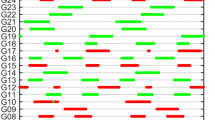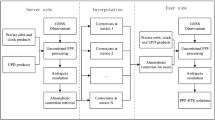Abstract
GNSS/INS combined technology is nowadays one of the most widely used high-precision positioning methods for outdoor users. However, the performance of the GNSS/INS combined system will be degraded when the satellite signals are subject to long-term obstruction or interference. A common way to overcome this limitation is to integrate the additional sensors, which increases additional expenses. Motivated by our previous work that the Tightly integrated Real-Time Kinematic (TRTK), which makes use of the additional inter-system differential observations of overlapping frequencies and can significantly improve the performance of the Loosely integrated RTK (LRTK) which directly stacks the intra-system differential observations and is currently used in the GNSS/INS combined system, we further study the enhanced GNSS/INS combined technique to improve the positioning performance by using TRTK, particularly in harsh environments. First, the difference between TRTK and LRTK are analytically addressed, and the uniform expression for three TRTK models specified by differential inter-system biases, i.e., DISB-float, -constant and -fixed models, are presented. Then, the GNSS/INS combined equations are derived based on the DISB-fixed TRTK model. Both semi-simulated and real field tests are carried out in different environments to show the improvements of GNSS/INS with TRTK compared to that with LRTK. The result shows that the TRTK-specified GNSS/INS combined model can significantly improve positioning accuracy, especially when the satellite signals suffer severe occlusion. Thanks to the four-system dual-frequency observations we used, at most 6 additional redundant observations will be introduced at each epoch in TRTK. Compared to the traditional algorithm, our proposed algorithm on average reduces the averaged horizontal position error by 53.2% for the two tests, and even by 73.1% in a situation where the number of visible satellites is less than about 7.











Similar content being viewed by others
Data availability
The datasets can be freely provided to readers by contacting the corresponding author on reasonable request.
References
Chen Q, Zhang Q, Niu X (2020) Estimate the pitch and heading mounting angles of the IMU for land vehicular GNSS/INS integrated system. IEEE Trans Intell Transp Syst 22(10):6503–6515
Chen G, Li B, Zhang Z, Liu T (2022) Integer ambiguity resolution and precise positioning for tight integration of BDS-3, GPS, GALILEO, and QZSS overlapping frequencies signals. GPS Solut 26(1):1–16
CSNO (2021) BeiDou navigation satellite system open service performance standard (version 3.0)
Gao Z, Ge M, Li Y, Chen Q, Zhang Q, Niu X, Zhang H, Shen W, Schuh H (2018) Odometer, low-cost inertial sensors, and four-GNSS data to enhance PPP and attitude determination. GPS Solut 22(3):1–16
Guo J, Li X, Li Z, Hu L, Yang G, Zhao C, Fairbairn D, Watson D, Ge M (2018) Multi-GNSS precise point positioning for precision agriculture. Precis Agric 19(5):895–911
Julien O, Alves P, Cannon ME, Zhang W (2003) A tightly coupled GPS/GALILEO integration for improved ambiguity resolution. In: proceedings of ENC-GNSS 2003, Graz, Austria, pp 22–25
Leick A, Rapoport L, Tatarnikov D (2015) GPS satellite surveying, 4th edn. Wiley, New York
Li B, Li Z, Zhang Z, Tan Y (2017) ERTK: extra-wide-lane RTK of triple-frequency GNSS signals. J Geod 91(9):1031–1047
Li G, Geng J, Guo J, Zhou S, Lin S (2018) GPS+Galileo tightly combined RTK positioning for medium-to-long baselines based on partial ambiguity resolution. J Glob Position Syst 16(1):3
Niu X, Wu Y, Kuang J (2021) Wheel-INS: A wheel-mounted MEMS IMU-based dead reckoning system. IEEE Trans Veh Technol 70(10):9814–9825
Obst M, Bauer S, Reisdorf P, Wanielik, G (2012) Multipath detection with 3D digital maps for robust multi-constellation GNSS/INS vehicle localization in urban areas[C]. In: 2012 IEEE Intelligent Vehicles Symposium. IEEE, pp 184–190
Odijk D, Teunissen PJG (2013) Estimation of differential inter-system biases between the overlapping frequencies of GPS, Galileo, BeiDou and QZSS. Proceedings of 4th international colloquium scientific and fundamental aspects of the Galileo programme. pp 4–6, Prague, Czech Republic
Paziewski J, Wielgosz P (2015) Accounting for Galileo-GPS intersystem biases in precise satellite positioning. J Geod 89(1):81–93
Qian C, Zhang H, Li W, Tang J, Liu H, Li B (2020) Cooperative GNSS-RTK Ambiguity Resolution with GNSS, INS, and LiDAR data for connected vehicles. Remote Sens 12(6):949
Rogers RM (2003) Applied mathematics in integrated navigation systems. American Institute of Aeronautics and Astronautics Inc, Florida
Romero I (2020) The receiver independent exchange format version 3.05
Shin E (2005) Estimation techniques for low-cost inertial navigation, Ph.D. Thesis, Department of Geomatics Engineering, University of Calgary, Canada
Yang Y, Lu M, Han C (2016) Some notes on interoperability of GNSS. Acta Geod Cartogr Sin 45(3):253–259
Zhang Z, Yuan H, Li B, He X, Gao S (2021) Feasibility of easy-to-implement methods to analyze systematic errors of multipath, differential code bias, and inter-system bias for low-cost receivers. GPS Solut 25(3):1–14
Zhang W, Cannon ME, Julien O, Alves P (2003) Investigation of combined GPS/GALILEO cascading ambiguity resolution schemes. In: ION GPS/GNSS-2003, Institute of Navigation, Portland, USA, pp 2599–2610
Zhu M, Liu X, Tang F, Qiu M, Shen R, Shu W, Wu M (2016) Public vehicles for future urban transportation. IEEE Trans Intell Transp Syst 17(12):3344–3353
Acknowledgements
This work is supported by the National Natural Science Funds of China (42074026, 41874030), the Innovation Program of Shanghai Municipal Education Commission (2021-01-07-00-07-E00095), the Program of Shanghai Academic Research Leader (20XD1423800), the “Shuguang Program” supported by Shanghai Education Development Foundation and Shanghai Municipal Education Commission (20SG18) and the Scientific and Technological Innovation Plan from Shanghai Science and Technology Committee (20511103302, 20511103402, 20511103702 and 21511103902).
Author information
Authors and Affiliations
Corresponding author
Additional information
Publisher's Note
Springer Nature remains neutral with regard to jurisdictional claims in published maps and institutional affiliations.
Rights and permissions
Springer Nature or its licensor holds exclusive rights to this article under a publishing agreement with the author(s) or other rightsholder(s); author self-archiving of the accepted manuscript version of this article is solely governed by the terms of such publishing agreement and applicable law.
About this article
Cite this article
Li, B., Chen, G. Improving the combined GNSS/INS positioning by using tightly integrated RTK. GPS Solut 26, 144 (2022). https://doi.org/10.1007/s10291-022-01331-2
Received:
Accepted:
Published:
DOI: https://doi.org/10.1007/s10291-022-01331-2




